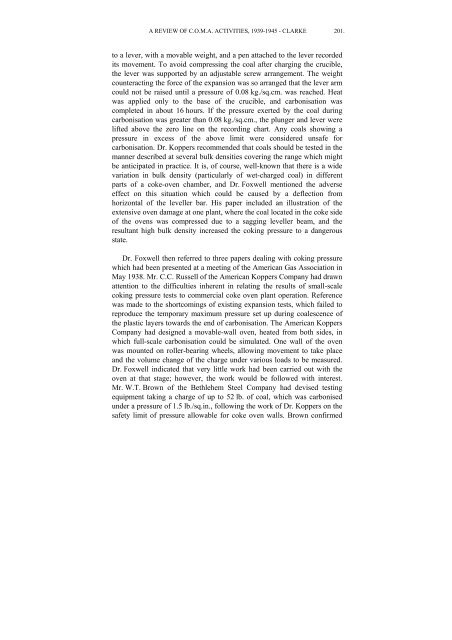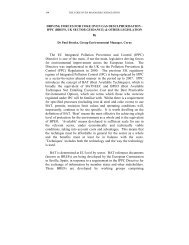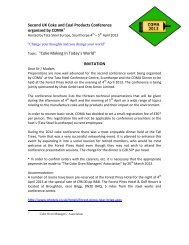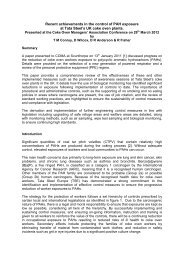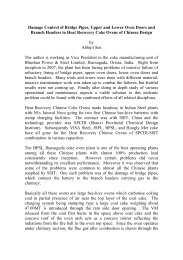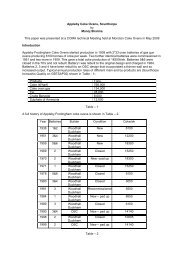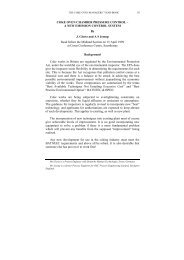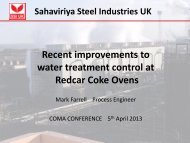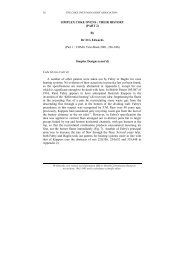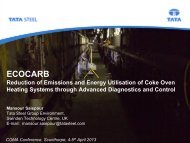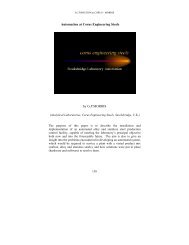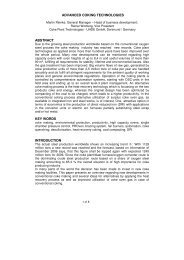CHAIRMAN'S ADDRESS - Coke Oven Managers Association
CHAIRMAN'S ADDRESS - Coke Oven Managers Association
CHAIRMAN'S ADDRESS - Coke Oven Managers Association
- No tags were found...
Create successful ePaper yourself
Turn your PDF publications into a flip-book with our unique Google optimized e-Paper software.
A REVIEW OF C.O.M.A. ACTIVITIES, 1939-1945 - CLARKE 201.to a lever, with a movable weight, and a pen attached to the lever recordedits movement. To avoid compressing the coal after charging the crucible,the lever was supported by an adjustable screw arrangement. The weightcounteracting the force of the expansion was so arranged that the lever armcould not be raised until a pressure of 0.08 kg./sq.cm. was reached. Heatwas applied only to the base of the crucible, and carbonisation wascompleted in about 16 hours. If the pressure exerted by the coal duringcarbonisation was greater than 0.08 kg./sq.cm., the plunger and lever werelifted above the zero line on the recording chart. Any coals showing apressure in excess of the above limit were considered unsafe forcarbonisation. Dr. Koppers recommended that coals should be tested in themanner described at several bulk densities covering the range which mightbe anticipated in practice. It is, of course, well-known that there is a widevariation in bulk density (particularly of wet-charged coal) in differentparts of a coke-oven chamber, and Dr. Foxwell mentioned the adverseeffect on this situation which could be caused by a deflection fromhorizontal of the leveller bar. His paper included an illustration of theextensive oven damage at one plant, where the coal located in the coke sideof the ovens was compressed due to a sagging leveller beam, and theresultant high bulk density increased the coking pressure to a dangerousstate.Dr. Foxwell then referred to three papers dealing with coking pressurewhich had been presented at a meeting of the American Gas <strong>Association</strong> inMay 1938. Mr. C.C. Russell of the American Koppers Company had drawnattention to the difficulties inherent in relating the results of small-scalecoking pressure tests to commercial coke oven plant operation. Referencewas made to the shortcomings of existing expansion tests, which failed toreproduce the temporary maximum pressure set up during coalescence ofthe plastic layers towards the end of carbonisation. The American KoppersCompany had designed a movable-wall oven, heated from both sides, inwhich full-scale carbonisation could be simulated. One wall of the ovenwas mounted on roller-bearing wheels, allowing movement to take placeand the volume change of the charge under various loads to be measured.Dr. Foxwell indicated that very little work had been carried out with theoven at that stage; however, the work would be followed with interest.Mr. W.T. Brown of the Bethlehem Steel Company had devised testingequipment taking a charge of up to 52 lb. of coal, which was carbonisedunder a pressure of 1.5 lb./sq.in., following the work of Dr. Koppers on thesafety limit of pressure allowable for coke oven walls. Brown confirmed


